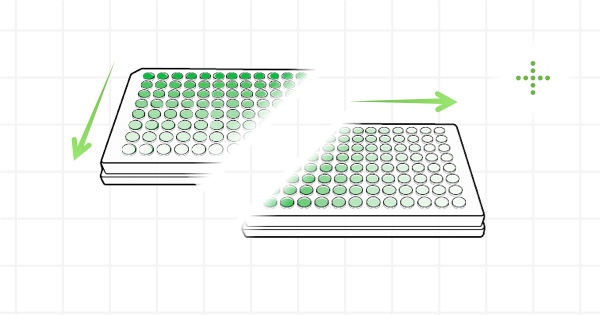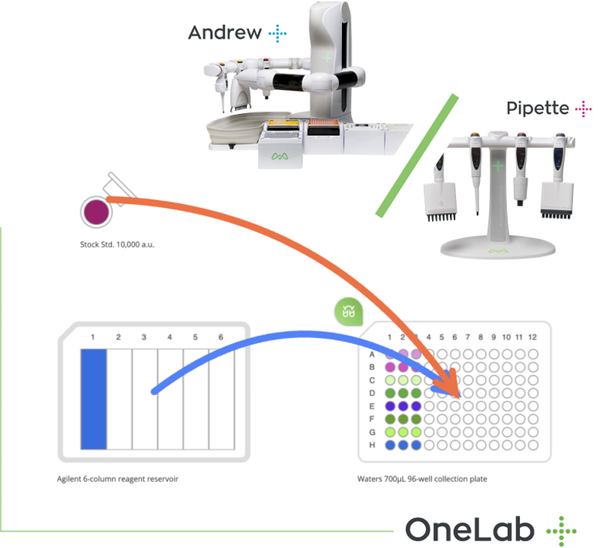or start from open source methods. Learn more about OneLab softwareUse OneLab
Simple Serial Dilution Preparation

This example method provides a freely adjustable framework for measuring the adaptability of the OneLab environment to workflows from different application fields. It helps to understand various nuances of the code-free, universal protocol designer and provides general indications as to the feasibility of a project. Scripts generally require fine adjustment to correct for variables and support specific labware implementation.
Overview
Enhance Serial Dilution Pipetting and Reproducibility Using OneLab and Pipette+
Serial dilutions are used for many laboratory assays. Workflows as diverse as ELISAs, protein quantification and quantitative LC-MS analysis all make use of serial dilutions in one form or another. However, the procedure for the preparation of serial dilutions is often time-consuming and is consequently prone to errors. Operator influence and practices account for most pipetting and mixing inaccuracies. Automating or semi-automating the procedure provides many benefits as it improves consistency between dilutions and enhances mixing efficiency.
The Pipette+ guided system using the OneLab software automatically sets up pipetting commands and instantly programs the connected pipettes, enabling the rapid and reproducible generation of serial dilutions.
1- Serial Dilution Preparation in Column-Wise Format
◼️ PROTOCOL 1A | Serial Dilution – 2-Fold by Column
This protocol is designed to create 2-fold serial dilutions using the columns of a 96-well collection plate (Figure 1).
PROCEDURE
A 7-point serial dilution plus a blank is created using a stock standard with a final volume of 500 μL. Single channel pipettes 300 and 1000 μL are used to create the serial dilution. This protocol enables rapid and reproducible creation of triplicate serial dilutions in a column-wise format that can be used for any appropriate assay.

Figure 1: Visual representation of the OneLab protocol designer showing the creation of a 2-fold serial dilution in triplicate in column-wise fashion. The same protocol can be executed either fully automated using the Andrew+ Pipetting Robot or Guided with the Pipette+ Smart System.
ORDERING INFORMATION
❙ System Components
➤ 2-Fold Serial Dilution by Column Protocol – Pipette+
- Pipette+ Stand | p/n 186009764
- Andrew Alliance Bluetooth Electronic Pipette, 1-ch 300 μL | p/n 186009606
- Andrew Alliance Bluetooth Electronic Pipette, 1-ch 1000 μL | p/n 186009766
- Sartorius, Optifit Tips, 5-350 μL (x6) | p/n 700013297
- Sartorius, Optifit Tips, 10-1000 μL (x3) | p/n 700013298
➤ 2-Fold Serial Dilution by Column Protocol – Andrew+
- 1x Microtube Domino | p/n 186009601
- 2x Deepwell Microplate Domino | p/n 186009597
- 2x Tip Insertion System Domino | p/n 186009612
- Andrew Alliance Bluetooth Electronic Pipette, 1-ch 300 μL | p/n 186009606
- Andrew Alliance Bluetooth Electronic Pipette, 1-ch 1000 μL | p/n 186009766
- Sartorius, Optifit Tips, 5-350 μL (x6) | p/n 700013297
- Sartorius, Optifit Tips, 10-1000 μL (x3) | p/n 700013298
❙❙ Consumables
- Eppendorf 2 mL Safe-Lock tube | p/n 0030120094
- Waters 700 μL 96-round well collection plate | p/n 186005837
- Agilent 6-column reagent reservoir | p/n 201284-100
◼️ PROTOCOL 1B | Serial Dilution – 5-Fold by Column
This protocol is designed to create 5-fold serial dilutions using the columns of a 96-well collection plate.
PROCEDURE
A 7-point serial dilution plus a blank is created using a stock standard with a final volume of 500 μL. Single channel pipettes 300 and 1000 μL are used to create the serial dilution. This method enables rapid and reproducible creation of triplicate serial dilutions in a column-wise format that can be used for any appropriate assay.
ORDERING INFORMATION
❙ System Components
➤ 5-Fold Serial Dilution by Column Protocol – Pipette+
- Pipette+ Stand | p/n 186009764
- Andrew Alliance Bluetooth Electronic Pipette, 1-ch 300 μL | p/n 186009606
- Andrew Alliance Bluetooth Electronic Pipette, 1-ch 1000 μL | p/n 186009766
- Sartorius, Optifit Tips, 5-350 μL (x3) | p/n 700013297
- Sartorius, Optifit Tips, 10-1000 μL (x6) | p/n 700013298
➤ 5-Fold Serial Dilution by Column Protocol – Andrew+
- 1x Microtube Domino | p/n 186009601
- 2x Deepwell Microplate Domino | p/n 186009597
- 2x Tip Insertion System Domino | p/n 186009612
- Andrew Alliance Bluetooth Electronic Pipette, 1-ch 300 μL | p/n 186009606
- Andrew Alliance Bluetooth Electronic Pipette, 1-ch 1000 μL | p/n 186009766
- Sartorius, Optifit Tips, 5-350 μL (x3) | p/n 700013297
- Sartorius, Optifit Tips, 10-1000 μL (x6) | p/n 700013298
❙❙ Consumables
- Eppendorf 2 mL Safe-Lock tube | p/n 0030120094
- Waters 700 μL 96-round well collection plate | p/n 186005837
- Agilent 6-column reagent reservoir | p/n 201284-100
2- Serial Dilution Preparation in Row-Wise Format
◼️ PROTOCOL 2A | Serial Dilution – 2-Fold by Row
This protocol is designed to create 2-fold serial dilutions using the rows of a 96-well collection plate (Figure 2).
PROCEDURE
An 11-point serial dilution plus a blank is created using a stock standard with a final volume of 500 μL. Single channel pipettes 300 and 1000 μL are used to create the serial dilution. This method enables rapid and reproducible creation of triplicate serial dilutions in a row-wise format that can be used for any appropriate assay.

Figure 2: Visual representation of the OneLab protocol designer showing the creation of a 2-fold serial dilution in triplicate in row-wise fashion. The same protocol can be executed either fully automated using the Andrew+ Pipetting Robot or Guided with the Pipette+ Smart System.
ORDERING INFORMATION
❙ System Components
➤ 2-Fold Serial Dilution by Row Protocol – Pipette+
- Pipette+ Stand | p/n 186009764
- Andrew Alliance Bluetooth Electronic Pipette, 1-ch 300 μL | p/n 186009606
- Andrew Alliance Bluetooth Electronic Pipette, 1-ch 1000 μL | p/n 186009766
- Sartorius, Optifit Tips, 5-350 μL (x6) | p/n 700013297
- Sartorius, Optifit Tips, 10-1000 μL (x3) | p/n 700013298
➤ 2-Fold Serial Dilution by Row Protocol – Andrew+
- 1x Microtube Domino | p/n 186009601
- 2x Deepwell Microplate Domino | p/n 186009597
- 2x Tip Insertion System Domino | p/n 186009612
- Andrew Alliance Bluetooth Electronic Pipette, 1-ch 300 μL | p/n 186009606
- Andrew Alliance Bluetooth Electronic Pipette, 1-ch 1000 μL | p/n 186009766
- Sartorius, Optifit Tips, 5-350 μL (x6) | p/n 700013297
- Sartorius, Optifit Tips, 10-1000 μL (x3) | p/n 700013298
❙❙ Consumables
- Eppendorf 2 mL Safe-Lock tube | p/n 0030120094
- Waters 700 μL 96-round well collection plate | p/n 186005837
- Agilent 6-column reagent reservoir | p/n 201284-100
◼️ PROTOCOL 2B | Serial Dilution – 5-Fold by Row
This protocol is designed to create 5-fold serial dilutions using the rows of a 96-well collection plate.
PROCEDURE
An 11-point serial dilution plus a blank is created using a stock standard with a final volume of 500 μL. Single channel pipettes 300 and 1000 μL are used to create the serial dilution. This method enables rapid and reproducible creation of triplicate serial dilutions in a row-wise format that can be used for any appropriate assay.
ORDERING INFORMATION
❙ System Components
➤ 5-Fold Serial Dilution by Row Protocol – Pipette+
- Pipette+ Stand | p/n 186009764
- Andrew Alliance Bluetooth Electronic Pipette, 1-ch 300 μL | p/n 186009606
- Andrew Alliance Bluetooth Electronic Pipette, 1-ch 1000 μL | p/n 186009766
- Sartorius, Optifit Tips, 5-350 μL (x3) | p/n 700013297
- Sartorius, Optifit Tips, 10-1000 μL (x6) | p/n 700013298
➤ 5-Fold Serial Dilution by Row Protocol – Andrew+
- 1x Microtube Domino | p/n 186009601
- 2x Deepwell Microplate Domino | p/n 186009597
- 2x Tip Insertion System Domino | p/n 186009612
- Andrew Alliance Bluetooth Electronic Pipette, 1-ch 300 μL | p/n 186009606
- Andrew Alliance Bluetooth Electronic Pipette, 1-ch 1000 μL | p/n 186009766
- Sartorius, Optifit Tips, 5-350 μL (x3) | p/n 700013297
- Sartorius, Optifit Tips, 10-1000 μL (x6) | p/n 700013298
❙❙ Consumables
- Eppendorf 2 mL Safe-Lock tube | p/n 0030120094
- Waters 700 μL 96-round well collection plate | p/n 186005837
- Agilent 6-column reagent reservoir | p/n 201284-100
Protocols




Contact info

 This is an open access protocol distributed under the terms of the Creative Commons Attribution License, which permits unrestricted use, distribution, and reproduction in any medium, provided the original author and source are credited.
This is an open access protocol distributed under the terms of the Creative Commons Attribution License, which permits unrestricted use, distribution, and reproduction in any medium, provided the original author and source are credited. 